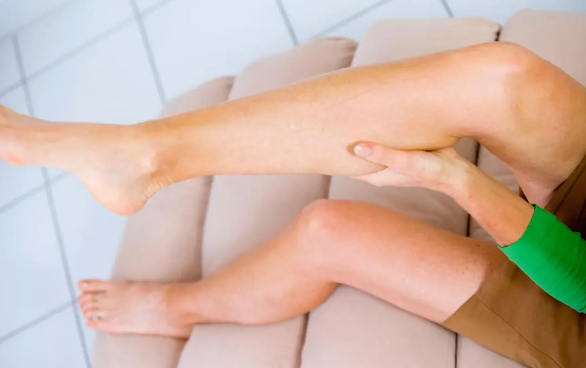Medical and Lifestyle Factors Contributing to Nighttime Leg Cramps
Nighttime leg cramps are a common yet poorly understood phenomenon that can disrupt sleep and significantly impact quality of life. These involuntary muscle contractions are typically sudden and can cause severe pain, lasting from a few seconds to several minutes. Although the question “What causes leg cramps?” remains elusive, several medical and lifestyle factors that may increase the risk or severity of these episodes have been identified. This article explores these factors in-depth, offering insights into how individuals can manage or potentially reduce the occurrence of nighttime leg cramps through lifestyle adjustments and effective holistic over-the-counter (OTC) products.
Dehydration and Electrolyte Imbalance
One of the primary medical explanations for leg cramps is dehydration and the imbalance of electrolytes in the body, particularly magnesium, potassium, and calcium. These minerals are crucial for proper muscle function and nerve transmission. When the body is dehydrated, or these electrolytes are not in balance, muscles may become hyperexcitable and prone to spasms. Ensuring adequate hydration and maintaining a balanced diet rich in these minerals can help mitigate this risk. Holistic OTC products that replenish electrolytes can be beneficial, especially those formulated to support nighttime muscle relaxation. When selecting these products, look for ones that provide a balanced blend of essential minerals in absorbable forms to ensure maximum efficacy. Reviews and certifications can guide purchases to ensure these products meet high quality and safety standards.
Physical Overexertion and Inadequate Rest
Physical overexertion without adequate rest can also lead to muscle fatigue, which may trigger cramps. Muscles overused during the day are more likely to contract involuntarily at night. It is essential for individuals who engage in high levels of physical activity to allow adequate recovery time for their muscles, which includes proper stretching, hydration, and rest. Integrating relaxation and recovery techniques into one’s daily routine can significantly reduce the frequency of cramps. Holistic OTC products such as magnesium or herbal muscle relaxants can be incorporated into post-exercise routines to aid recovery and prevent cramping. Ensure these products are sourced from reputable suppliers and contain scientifically proven ingredients for muscle recovery. Maintaining electrolyte balance through proper hydration and consuming potassium-rich foods can further support muscle function and reduce the risk of cramping due to physical overexertion.
Medication Side Effects and Medical Conditions
Certain medications and medical conditions are known to be associated with an increased risk of developing leg cramps. Diuretics to treat high blood pressure can increase urine output and reduce electrolyte levels, while statins and certain asthma medications may interfere with muscle function. Conditions such as diabetes and peripheral artery disease (PAD) can also affect the blood supply to the muscles, increasing cramp risks. Individuals should consult healthcare providers to understand the potential side effects of their medications or manage underlying conditions that may contribute to cramps. Complementary, holistic OTC products, such as those containing antioxidants and anti-inflammatory agents, can help manage these conditions by supporting overall circulatory and muscle health.
Well, sometimes wrong knee replacement leads to these type of leg cramp conditions. So, its better to consider a knee specialist singapore and be safe.
Poor Sleeping Positions and Ergonomics
Improper sleeping positions can exacerbate the likelihood of experiencing leg cramps during the night. For example, sleeping in a position that shortens the calf muscles can increase the chance of cramps. Adjusting one’s sleep environment to promote ergonomic positions, using supportive mattresses and pillows, and ensuring that bedding does not restrict leg movement can help reduce cramps. Additionally, ergonomic adjustments in daily activities, supported by products designed to enhance comfort and reduce strain, can be beneficial. Holistic OTC products, such as specially designed pillows or pills that relax muscles, can be practical additions to improve sleep ergonomics and reduce the risk of nocturnal cramps.
Age-Related Muscle and Nerve Changes
As individuals age, muscle and nerve function changes can increase their susceptibility to cramps. Muscle mass decreases, and nerve conduction slows, which can contribute to the muscles’ tendency to cramp. Maintaining an active lifestyle, with regular exercise tailored to one’s abilities, can help mitigate some of these age-related changes. holistic OTC products designed to support muscle and nerve health can provide further benefits in managing symptoms associated with aging. Look for natural ingredients that support nerve health and muscle function, such as vitamin B complex, omega-3 fatty acids, and herbal extracts like turmeric and ginger, which have natural anti-inflammatory properties.
Understanding what causes leg cramps and the medical and lifestyle factors contributing to nighttime leg cramps is crucial for managing and potentially preventing this uncomfortable condition. Proper hydration, balanced nutrition, adequate rest and recovery after physical activity, management of medications and medical conditions, ergonomic sleep settings, and adjustments to lifestyle as one ages are all vital components in the battle against nighttime leg cramps. For those seeking additional support, holistic over-the-counter products can offer relief and aid in maintaining muscle health. By addressing these factors, individuals can take proactive steps towards minimising the impact of leg cramps and enhancing their overall quality of life.







